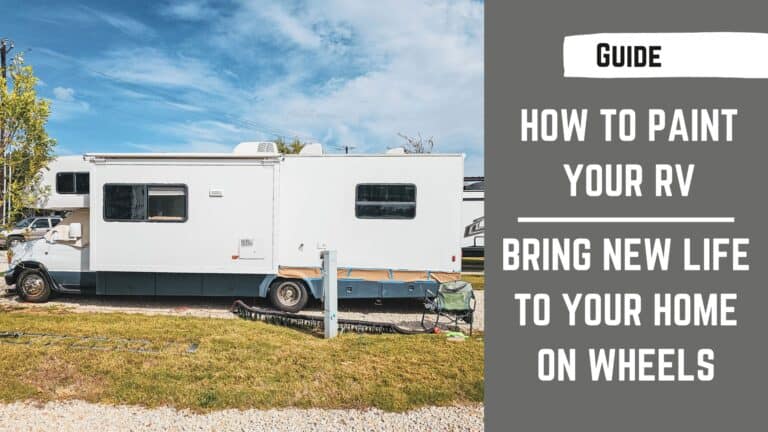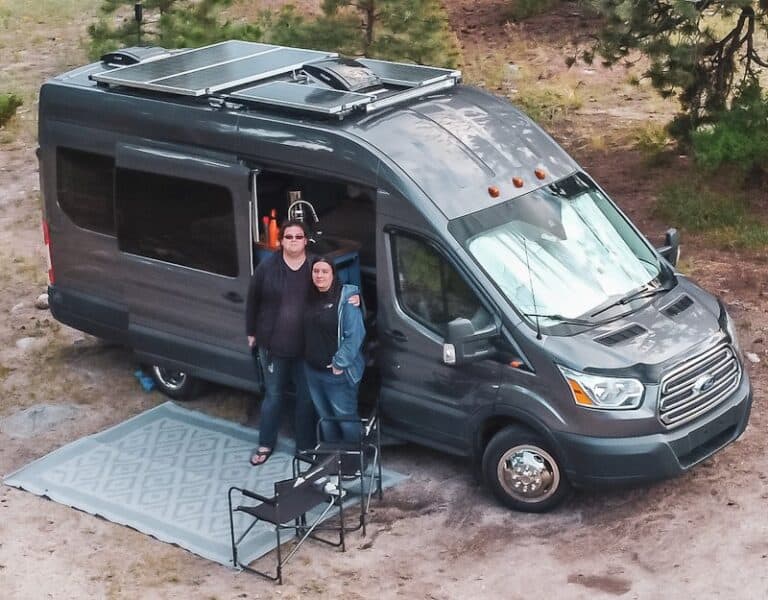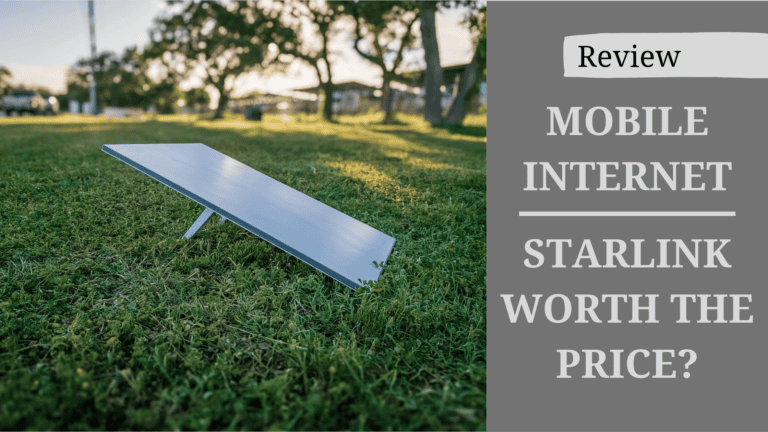Perhaps the biggest debate in the van life community is whether to have a toilet for your campervan or not. Everyone has thoughts on the subject, and everyone gets asked the same two questions by people interested in starting to travel out of a van themselves. Where do you go to the bathroom? What toilet do you use for your campervan?
Some people find that not having a toilet in their van works best for them. Others go all out and have full bathrooms inside their van, including having a shower built into their bathroom. In our van, we have a hideaway campervan toilet inside our coach, so it doesn’t take up much space.
So should you have a campervan toilet? What are the different types of mobile toilet solutions there for vans? And what are our thoughts on what works best for us after using most of the options out there?
Should You Have A Campervan Toilet
We are a bit biased when it comes to the debate on whether you should have a campervan toilet in your rig or not. There are a lot of van lifers out there that give a million reasons why they didn’t include a toilet in their van build and how great it works for them, and that’s great, but it is not for us.
For us, and the way we travel. Having a campervan toilet is a necessity that comes down to a few key reasons.
- Comfort and convenience: While traveling, you will have your toilet with you. You won’t have to constantly use pit toilets, porta-potties, or public toilets. Wherever you go, you have a bathroom. Whether you are at a trailhead, down a dirt road, or staying the night at a rest stop. When you need to go, you won’t have to find the nearest public restroom or go outside and dig a hole.
- You don’t have to use public bathrooms: Let’s face it, public toilets can be hit or miss regarding cleanliness. Plus, you may not want to find and use a public restroom in the middle of the night if the need arises. You can relieve yourself in the privacy and safety of your own van whenever needed.
- Safety: If you are a solo traveler, LGBTQIA+, or part of any community that may experience harassment. Being able to avoid public restrooms, especially at night, is a massive benefit of having a campervan toilet. Plus, you do not have any risk of people pulling up to your campsite while you are going outside when you have a bathroom inside your van.
- Your van will be your home while on the road: If you will be traveling in your van full time and not just for a few days here and there, then your van will quickly become your home. In our opinion, having a toilet in your home just makes everything a bit easier. It’s a bit of added convenience, comfort, and safety.
Suggested Reading: How To Insulate Your Van
Best Toilet for a Campervan Options
There are many excellent toilets for campervan options, but the two most popular types are cassette toilets and composting toilets.
Thetford Porta Potti 565E – Our Current Top Pick
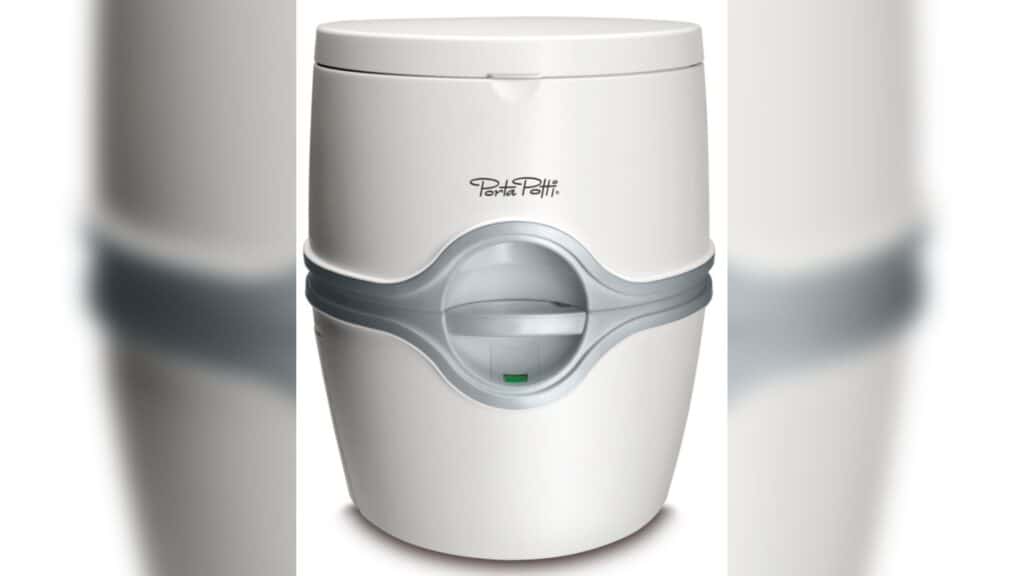
Price: $156
Since going tiny in 2018, we have had an RV toilet with a black tank, a DIY composting toilet, and a cassette toilet. We like the Thetford 565E cassette toilet the most out of all the campervan toilets we have used.
RV toilets with a holding tank are hard to install yourself in a van or bus build, plus they are a pain (and potentially a mess) to empty. The DIY composting toilet we built was never truly odorless, and having to empty the liquids container daily was a massive pain (plus the liquids, when concentrated into a single bottle, really smell even with vinegar added).
Our Thetford cassette toilet, on the other hand, just works. It doesn’t take up much space inside our campervan; it doesn’t smell, it is easy to empty, easy to keep clean, and it feels much like a traditional toilet when sitting on it. We use our cassette toilet as our primary toilet as we prefer to avoid public bathrooms as much as possible and have never had an issue.
We like the Thetford 565E the most out of all the cassette toilet options. It has the largest holding tank capacity of five and a half gallons, along with a four-gallon freshwater tank for the electric flush. For two people using the 565E full-time, we can go three to four days before needing to empty it. If you are a solo traveler, you should be able to go about six days before needing to dump the toilet.
Update as of October 2022
We just finished up a trip through New England, where we had difficulty finding locations to dump our cassette toilet. In Maine, New Hampshire, and eastern New York, there is not the camping infrastructure like there is out west. Finding state parks with dump stations was nearly impossible, and pit toilets are far and few. Due to this, we are thinking of going with a composting toilet for our next rig. That way, we are not as tied to dump spots as we are with a cassette toilet.
Pros:
- Large 5.5-gallon holding tank.
- 4-gallon freshwater tank with electric flush.
- Comfortable to use.
- No smell when used correctly.
- Easy to empty.
- Doesn’t take up much room.
Cons:
- Have to remove the entire unit to dump.
Natures Head Composting Toilet
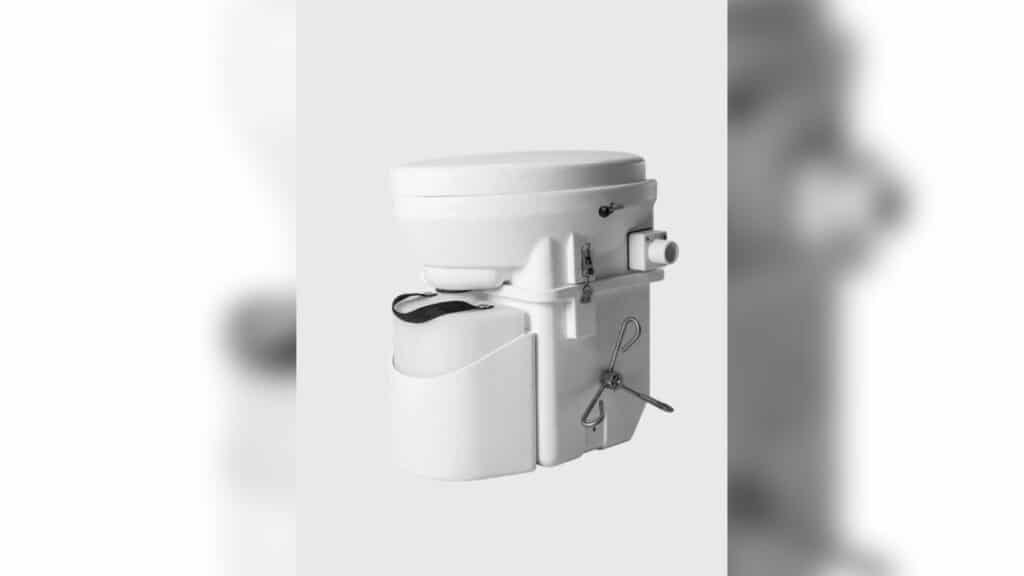
Price: $995
Nature’s Head composting toilets are a popular option that many people in vans, buses, and even RVs choose to go with, but what exactly is a composting toilet?
Despite what the name may suggest, when used the way most travelers use them, composting toilets do not fully compost. Composting toilets work by diverting fluids (#1) from where the solids (#2) are stored. The solids are combined with a composting medium that helps dry out moisture. A ventilation fan is also used to pull any remaining moisture and odors outside the van.
When the solids container is full, you bag up the solids in a trash bag and toss it in your local dumpster. To fully compost, you would need to add the solids to a compost pile and leave it for close to a year for the composting process to be fully complete.
When the fluids container is full, you will need to empty it into an RV dump station, pit toilet, or public restroom. In general, it is not recommended to dump your fluids container on the ground at your campsite as the high concentration of urine can potentially negatively impact local wildlife and waterways.
Pros:
- Looks and feels like a standard toilet in a house.
- When used correctly can be odorless.
Cons:
- High price, coming in at just under $1,000 the Nature’s Head can take a large chunk of your build budget.
- Need to carry composting medium such as peat moss with you.
- Fluids often need to be emptied daily and can really smell.
- Have to remove the entire toilet from the rig to empty the solids container.
DIY Composting Toilet
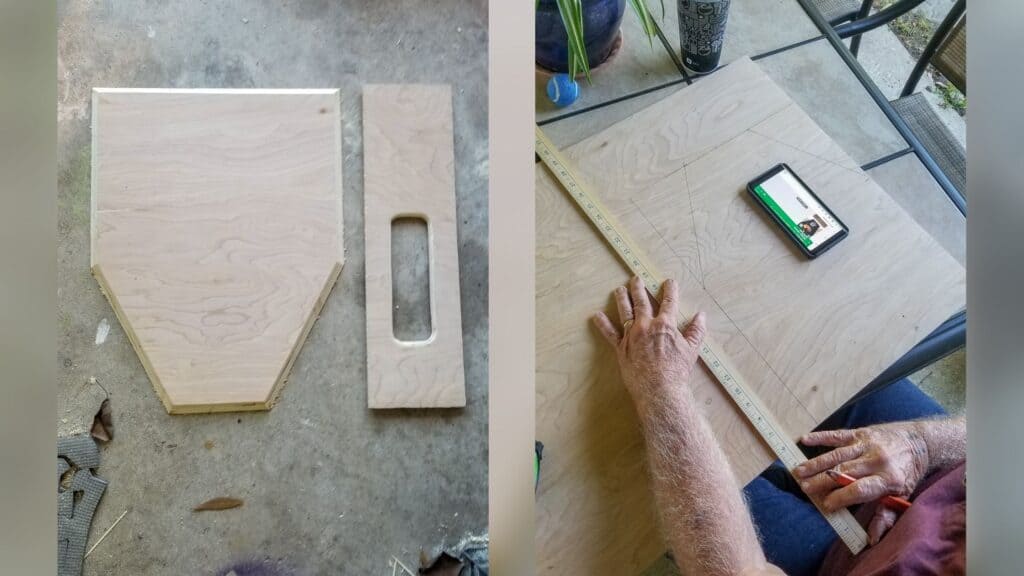
Price: $50 – $250
Composting toilets can be as expensive and complex or as cheap and straightforward as you want them to be. At the core, they all work the same way, so it really comes down to how much you want to spend and what you are looking for. You can build a composting toilet for your campervan for a tenth of the price of most commercially produced toilets.
When we built a composting toilet that we used in our campervan, we found a fluid diverter online and built a toilet that could hold a gallon jug for fluids and a five-gallon bucket for solids for less than $100. We wish we had included two things in our DIY composting toilet.
- Have a computer fan that vents outside of the van. We highly recommend adding a computer fan to vent outside to help with odors and moisture management. There is a reason why expensive composting toilets implement a vent fan.
- Have a sealing system that prevents odors from entering the van. Even a thin sealed board that sits under the toilet seat can help with odor control when not in use. We’ve seen a lot of DIY composting toilets that only use a toilet seat to block the opening to the solids container. We found that to not be enough, especially if you do not have a vent fan.
We found that when people talk about how odorless composting toilets are, it is mainly due to a vent fan and a seal on the solids chamber, not because the actual process is odorless.
Pros:
- Cheaper than buying a composting toilet.
- It can be built to any size needed for your build. Some people build a freestanding unit, while others build a bench-like structure to house the toilet.
Cons:
- Has to be built.
- It may not be as odorless as pre-built composting toilets are.
Other Popular Campervan Toilets
Cassette and composting toilets are the two most popular campervan toilets for people who want a full-use bathroom in their van. Not everyone chooses to have a campervan toilet that they primarily use, instead opting to use public restrooms. In our opinion, it is a good idea to still carry some type of toilet option with you for emergencies.
Dry Flush Toilet
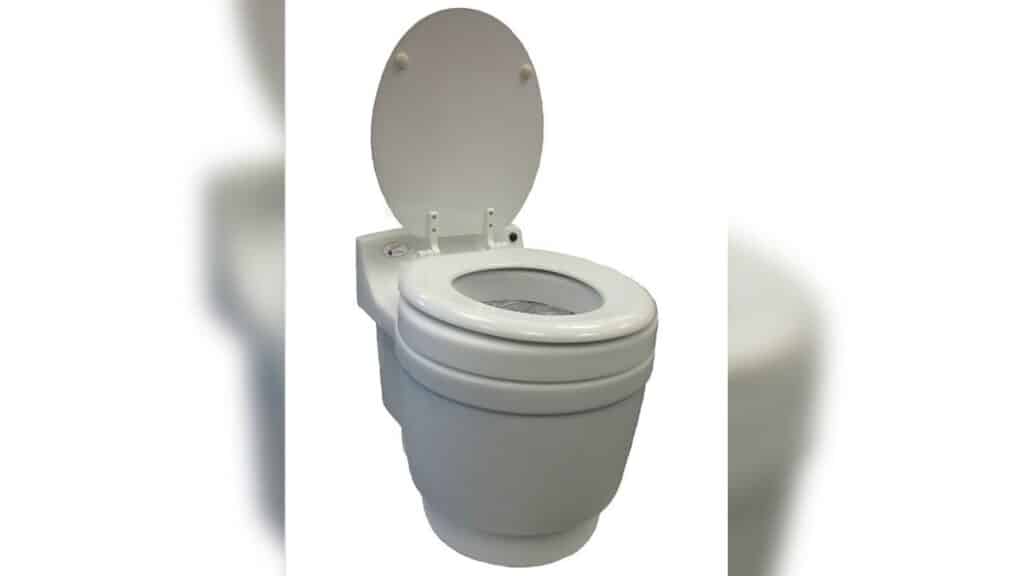
Price: $785
Dry flush toilets can be a good option if you plan on rarely using your campervan toilet but still want something for late-night emergencies.
A dry flush toilet works by having a large mylar bag that holds all the waste. After each “flush,” the toilet spins the bag closed to prevent odors and then opens the next section of the bag to be used next. Once the bag cartridge is empty, you remove the entire bag and toss it in a dumpster.
The biggest issue with dry flush campervan toilets is that they have a recurring cost attached to them. Dry flush toilets use bag cartridges. Each cartridge has about 15 flushes before the cartridge needs to be replaced. A three-pack of replacement cartridges costs $64, so the costs can add up quickly.
Overall, we like how dry flush toilets work, but we don’t believe they are a viable full-time use toilet option due to the recurring cost. If you are looking for a campervan toilet for emergency use or for a weekender van, a dry flush toilet may be an excellent option for you.
Pros:
- Odorless.
- Powered by batteries.
- Easy to empty.
Cons:
- High recurring costs.
Luggable Loo / Bucket Toilet
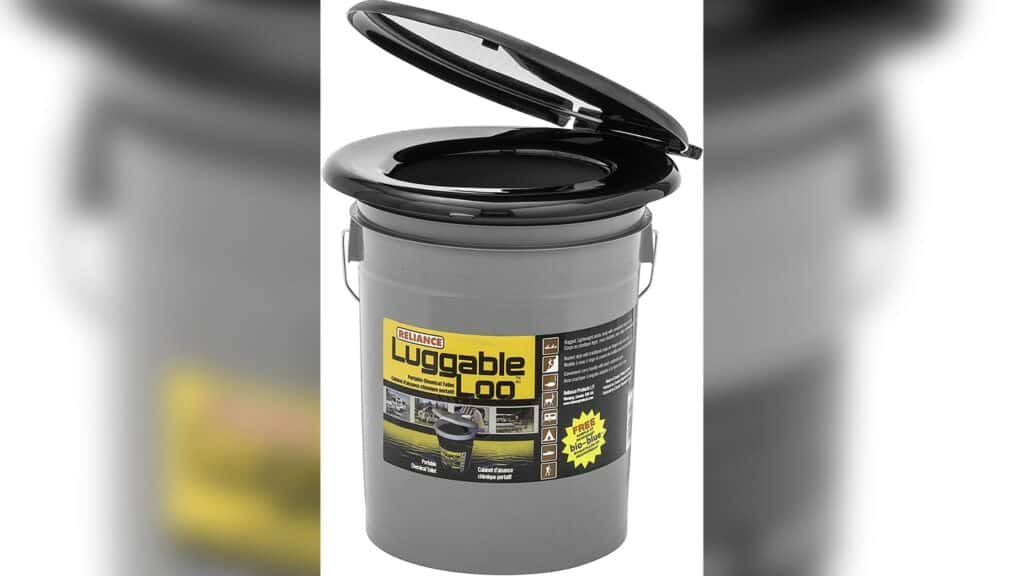
Price: $20
A bucket toilet works just like it sounds like it would. A bucket toilet is essentially a five-gallon bucket lined with a trash bag with a toilet seat lid that seals to prevent spills and odors.
You can find five-gallon bucket toilet seat lids online and use any 5-gal bucket that you already have to put together your portable campervan toilet. Or you can buy a ready-to-use bucket toilet online. We recommend adding some cat litter to the bottom of the trash bag to help absorb moisture.
Pros
- Does not take up much room.
- Works for emergencies or short multiday use; add more cat litter after each use.
- It can be used as storage when not used
Cons
- Takes up space when not in use.
Portable Folding Toilet
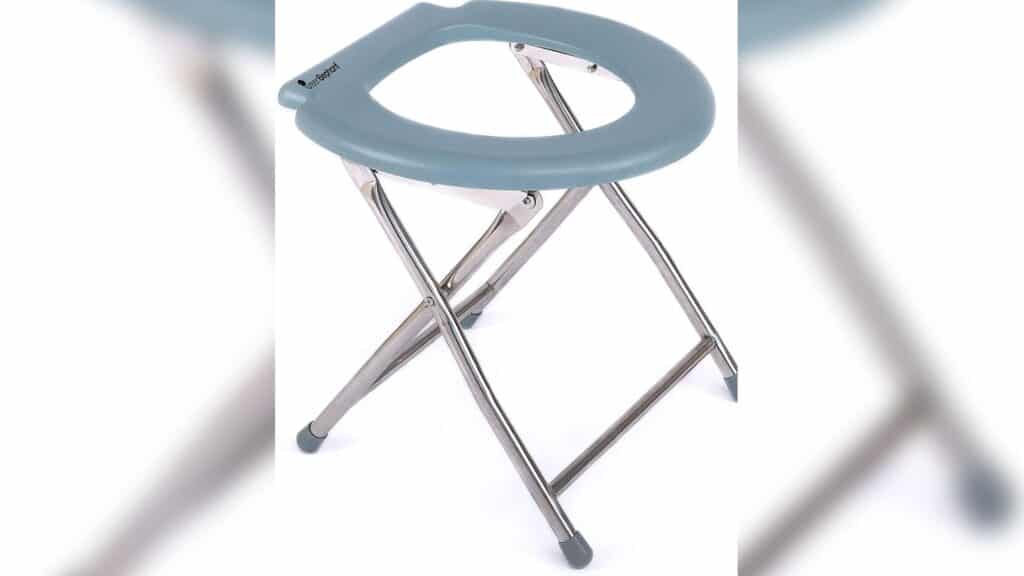
Price: $50
A folding camping toilet may be a good option if you are looking for a genuinely low-profile campervan toilet that does not take up much space. A folding camping toilet is essentially a bucket toilet without the bucket, as they are simply a toilet seat on legs. Folding camping toilets are designed to have a trash bag attached under the seat that gets tossed after each use.
Folding camping toilets take up very litter space and be stored almost anywhere inside your campervan when not in use.
Pros
- Takes up very little space.
Cons
- Have to be emptied after each use.
Do Campervan Toilets Smell?
One of the biggest concerns people have about having a toilet for their campervan is whether or not it will smell. When traveling in a tiny space like a van, bus, or RV, even a very little smell can quickly overwhelm your living space, and no one wants to have their van smell of sewage.
It is true that all campervan toilets have a chance of smelling. Unfortunately, there is no such thing as a flush-and-forget campervan toilet. No matter what kind of toilet option you choose to go with, you will have to deal with carrying and disposing of your waste. That does not mean that you have to deal with a smelly campervan toilet.
In our experience, our DIY composting toilet was never truly odorless. It didn’t necessarily smell of sewage, but it did always smell of peat moss. Something we couldn’t handle while traveling in a small space. I’m sure if we had a good ventilation fan installed in the toilet, we would not have had as many odor problems as we did.
By far, the best toilet for our campervan we have used has been our Thetford cassette toilet, partly because it never smells bad. Using an RV toilet treatment solution is highly recommended to break down waste and prevent odors with cassette toilets. Our go-to treatment is called TST Max. We find that TST works the best out of all the available options out there.
After each dump, we add a bit to the cassette holding tank, and the RV toilet treatment goes to work, breaking down waste and preventing any bad smells. Sometimes, even with the toilet treatment, you may get a bit of a bad smell when you flush. Just add a bit more toilet treatment to the holding tank if that ever happens, and any foul odors will quickly disappear.
In addition to the RV toilet treatment, we like to add a cap full of Downy to our cassette’s holding tank now and then. The Downy will leave the toilet and its contents smelling like fabric softeners. The best part is Downy is all-natural.
Where To Empty Campervan Toilets
Part of having a toilet in your campervan is having to empty it. Luckily whether you decide to go with composting or cassette emptying a campervan toilet is no big deal.
For composting toilets, you will have to deal with emptying both the solids and the liquids. For the solids, just bag up all the waste, tie a good knot to keep the bag closed, and you can toss the bag in your local dumpster. You will need to find a bathroom of some sort to dump the liquids, such as a pit toilet, porta potty, or public restroom. Alternatively, you can also use an RV dump station if need be.
Most people with a composting toilet in their van end up dumping their liquid container on the ground by their campsite. If you do this, follow proper rules to avoid affecting local wildlife or waterways. Proper rules would include:
- Do not dump any liquids within 200 feet of a water source (river, lake, stream, etc.).
- If possible, dig a hole or trench to pour into that is then covered once you have dumped.
- Most importantly, practice leaving no trace. You want your campsite to remain beautiful and in its natural state, not reeking of urine.
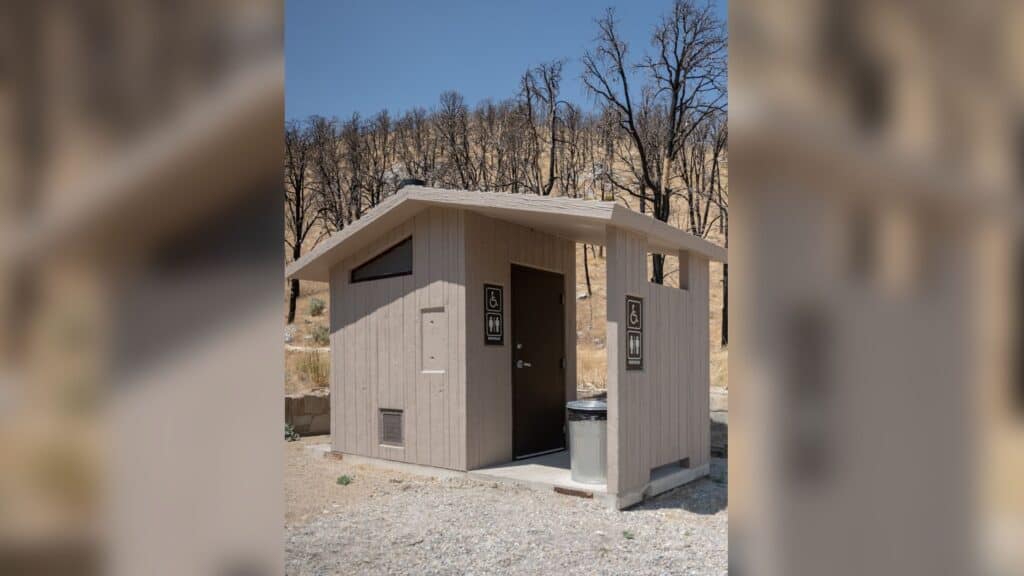
Cassette toilets are a bit simpler to empty as there is only one holding tank you will need to deal with. Most cassette toilets work by having a detachable lower half that contains the cassette. The upper part of the toilet will have a bowl and a freshwater tank for flushes. There are many places where you can empty your cassette toilet, including:
- Pit toilets: Simply dump the contents of your cassette into the pit toilet, making sure not to leave any mess behind for the following users. Pit toilets are our go-to place for dumping a cassette toilet. From the time we pull up to a pit toilet to when we have our cassette empty and back in the van can take less than a minute.
- Porta potties: Same as pit toilets; just make sure not to leave a mess. Even if there is some stuff already on the floor, when you enter, clean up some.
- RV dump stations are our least favorite places to empty a cassette toilet, as RV dump stations are not designed for cassettes. RV dump stations typically have a cap covering the hole you dump into. Unfortunately, that cap never opens wide enough for cassette toilets, making it easy to make a small mess. All RV dump stations have a non-potable water hose on-site that you can use to wash down their area to clean up any spills that may happen.
- Public bathrooms: we can not speak about using a public toilet to dump a cassette toilet as we have not done it before. We know a few people who do use public bathrooms, and they do not have any issues. You will have to flush the toilet you dump into a few times as you dump, though, if you have a larger cassette toilet.
No matter what type of campervan toilet you choose to go with or where you empty it, the most important part to remember is always leave the place cleaner than when you got there. When you leave a mess in a pit toilet, bathroom, or campsite, even if it is not yours, whoever uses that place after you will think you made the mess. And associate that mess with everyone who travels in a van, bus, RV, or car—making traveling harder for everyone.
What Works Best For You?
In our experience, we find the Thetford cassette toilet to work the best for us, but what everyone wants and finds works best for them is different. If you just have a campervan for weekend trips, what you want may be different than if you plan on traveling full time out of your van. If you have a short van vs. an extended van, or even a skoolie of any size, how much space you have available for your toilet will vary.
Ultimately having a campervan toilet is an excellent addition to any vehicle you will be traveling in. Campervan toilets don’t smell when used correctly, they don’t have to take up a lot of space, and most can even be placed outside of your campervan in a shower tent if need be.
Don’t feel like you have to spend $1,000 on a top-of-the-line composting toilet just because it’s what everyone else seems to use. Many great options will work for you at a fraction of the cost and if ultimately you decide a top-tier composting toilet will work best for you, then do it.
We didn’t finish the bathroom in our van until 6 months of travel. We didn’t want to lock ourselves into size dimensions when we weren’t sure exactly what would work best for us. Once we figured out what worked for us, we finished building our couch so that our campervan toilet was hidden inside of it.
It just comes down to what works best for you.

